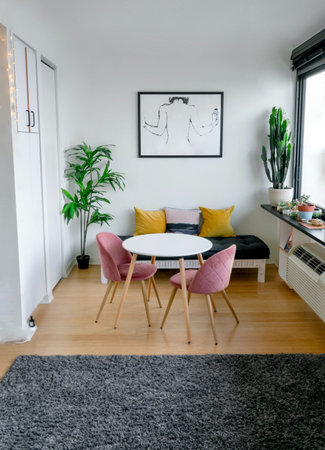1. Understanding Feng Shui: Foundations for a Harmonious Home
Feng Shui is an ancient Chinese practice focused on creating harmony between individuals and their living spaces. Although its roots go back thousands of years, the core ideas of Feng Shui can be easily blended with modern interior design to create balanced and inviting American homes. By understanding its basic principles, you can transform your space into a sanctuary that feels both stylish and peaceful.
What Is Feng Shui?
At its heart, Feng Shui is about arranging your environment to support your well-being. The philosophy centers on the flow of energy, known as “Chi,” through your home. When energy moves smoothly, it brings positive feelings, health, and success. If energy gets stuck or blocked, it can create stress and discomfort in your daily life.
Core Principles of Feng Shui
Below are some fundamental concepts that form the foundation of Feng Shui:
| Principle | Description | Modern Application in American Homes |
|---|---|---|
| Chi (Energy Flow) | The invisible life force that should move freely throughout your home. | Keep pathways clear and avoid clutter, especially near entrances and hallways. |
| The Five Elements | Wood, Fire, Earth, Metal, and Water—each element represents different qualities. | Add natural materials like wood furniture or water features to balance energy. |
| Yin and Yang | The balance between opposite forces: soft/hard, light/dark, active/calm. | Mix cozy textiles with sleek surfaces; use both bright and soft lighting. |
| The Bagua Map | An energy map used to analyze the layout of your home. | Use the Bagua to identify areas for wealth, relationships, or health and enhance them with décor choices. |
Why Feng Shui Matters in Modern Homes
American homes come in all shapes and sizes—from city apartments to suburban houses. Regardless of style or size, integrating Feng Shui principles can help every home feel more welcoming. Simple changes like rearranging furniture for better flow or bringing in more natural light can make a big difference. You dont have to follow every rule perfectly; even small steps toward harmony can boost comfort and positivity in your everyday life.
2. Modern Interior Design Trends in the U.S.
When it comes to American homes, interior design is all about creating a space that feels welcoming, practical, and uniquely personal. Over the years, several modern design trends have emerged that reflect these values. Understanding these styles can help you see how Feng Shui principles might blend seamlessly with American preferences.
Popular Interior Design Styles in American Homes
| Style Name | Main Features | Focus Areas |
|---|---|---|
| Modern Farmhouse | Mix of rustic charm and modern comforts; neutral colors; natural materials like wood and metal | Cozy atmosphere, open layouts, inviting kitchens |
| Mid-Century Modern | Clean lines, functional furniture, bold accent colors, lots of natural light | Simplicity, form meets function, retro vibes |
| Scandinavian | Minimalism, light color palette, simple yet functional furniture, use of textures | Calmness, organization, airy spaces |
| Bohemian (Boho) | Eclectic décor, vibrant colors, layered textiles, lots of plants and personal items | Personal expression, creativity, relaxed feel |
| Industrial | Exposed brick and pipes, metal fixtures, neutral tones mixed with darker shades | Urban vibe, raw finishes, open spaces |
The Priorities: Comfort, Functionality & Self-Expression
Comfort: Americans love homes that feel comfortable and lived-in. Overstuffed sofas, soft throws, and inviting bedrooms are staples. Whether it’s a cozy reading nook or a family-friendly living room, comfort is always top of mind.
Functionality: Open-concept layouts are popular because they make movement easy and keep families connected. Multipurpose rooms (like home offices or playrooms) show how important flexibility is in American design.
Personal Expression: Many homeowners enjoy decorating with art pieces, family photos, DIY projects or souvenirs from travels. These personal touches let individuals showcase their personality and memories throughout their space.
The Connection to Feng Shui Principles
The focus on comfort and positive energy in American design naturally connects to Feng Shui ideas about harmony and balance. For example:
- Clever furniture placement: Both modern design and Feng Shui value open pathways for easy flow—whether it’s energy (chi) or just foot traffic.
- Natural elements: Popular styles like Modern Farmhouse or Scandinavian often use wood or plants—elements that also support good Feng Shui.
- Personal touches: Displaying meaningful items echoes Feng Shui’s encouragement to fill your home with objects that inspire happiness and peace.
A Look Ahead: Merging the Best of Both Worlds
By recognizing what makes American interiors special—comfort, practicality and individuality—it becomes easier to see how Feng Shui principles can enhance these qualities rather than compete with them. In the next section, we’ll explore actionable ways to bring both approaches together in your own home.

3. Bridging Traditions: Incorporating Feng Shui into Modern Spaces
When it comes to designing an American home that feels both stylish and balanced, blending Feng Shui principles with modern aesthetics can be easier than you think. Here’s how you can seamlessly integrate key Feng Shui elements—like flow, placement, and color—into your favorite interior design styles.
Understanding the Flow of Energy (Chi)
One of the core ideas in Feng Shui is maintaining a good flow of energy, or “Chi,” throughout your home. In American homes, open floor plans are very popular and naturally support this principle. To further enhance the flow:
- Keep pathways clear: Avoid blocking entrances or walkways with furniture.
- Arrange furniture for conversation: Position sofas and chairs so people can see each other easily, which also helps energy circulate.
- Let in natural light: Use sheer curtains or blinds to maximize sunlight while keeping things cozy.
The Power of Placement
Where you place your furniture matters in Feng Shui, and it can also boost comfort and style. Here are some practical tips for popular spaces:
| Room | Feng Shui Suggestion | Modern American Style Tip |
|---|---|---|
| Living Room | Sofa against a solid wall, facing the entrance if possible. | Add a statement rug or throw pillows for a touch of personality. |
| Bedroom | Bed’s headboard against a wall, not directly facing the door. | Use neutral bedding with accent colors for a calm vibe. |
| Home Office | Desk positioned so you face the door (the “command position”). | Add motivational art or greenery for inspiration. |
Selecting Colors with Intention
Color plays a big role in both Feng Shui and American interior design. The right palette can make your space feel welcoming and harmonious. Here’s how you can blend both approaches:
- Earthy tones (beige, tan, soft greens): Create stability and go well with farmhouse or rustic styles.
- Pale blues and whites: Promote calmness—perfect for coastal or contemporary designs.
- Pops of red or yellow: Invite energy; use as accents in pillows, art, or decor pieces.
Quick Reference: Feng Shui Elements & American Design Match-Ups
| Feng Shui Element | Aesthetic Match |
|---|---|
| Wood (growth & vitality) | MID-CENTURY MODERN: Walnut furniture, indoor plants |
| Metal (clarity & precision) | INDUSTRIAL: Steel lamps, metal picture frames |
| Water (flow & relaxation) | COASTAL: Blue tones, water-themed artwork |
| Fire (energy & passion) | ECLECTIC/BOHO: Candles, bold red cushions |
| Earth (stability & balance) | RUSTIC/FARMHOUSE: Clay pots, stone decor items |
A Few More Practical Tips
- Add mirrors to reflect light but avoid placing them directly across from doors—it can bounce energy out of the room.
- Keeps clutter at bay for better energy flow; baskets and stylish storage bins work great in modern homes.
- Select meaningful decor: Display personal photos or travel souvenirs to create positive vibes unique to your family.
The Takeaway on Blending Styles
You don’t have to choose between tradition and trend. With these simple ideas, you can enjoy the best of both worlds—a home that’s beautiful by American standards and harmonious according to ancient Feng Shui wisdom.
4. Room-by-Room Applications
Blending Feng Shui principles with modern interior design is easier than you might think, especially when you focus on each room’s unique function and energy. Here’s how you can bring harmony and style to key areas of your American home.
Living Room
The living room is the heart of social gatherings and family relaxation. To balance comfort and good energy:
| Feng Shui Tip | Modern Design Practice |
|---|---|
| Place sofas and chairs so they face the main entrance but are not directly in line with the door. | Create open seating arrangements that encourage conversation and a welcoming feel. |
| Use round or oval coffee tables for smoother energy flow. | Choose soft-edged furniture to soften the overall look and prevent bumps in high-traffic areas. |
| Add plants to bring life and vitality, but keep them healthy and well-maintained. | Incorporate easy-care greenery like snake plants or pothos for a fresh, modern vibe. |
Kitchen
The kitchen represents health and abundance. It’s important to keep it clean, organized, and bright:
- Keep countertops clear of clutter for both visual appeal and better chi (energy) flow.
- Mix warm colors like yellows or earth tones in backsplashes or decor to promote nourishment.
- Ensure all appliances are working well—fix leaks promptly for good Feng Shui and practical maintenance.
- If possible, avoid placing the stove directly across from the sink or refrigerator; use a rug or decorative element to “buffer” if needed.
Bedrooms
Your bedroom should be a restful sanctuary. Try these tips for balance and tranquility:
| Feng Shui Guideline | Interior Design Application |
|---|---|
| Position your bed so you can see the door without being directly in line with it (“command position”). | Arrange the bed against a solid wall, away from windows and doors when possible for comfort and privacy. |
| Avoid mirrors facing the bed—they can disrupt sleep according to Feng Shui principles. | If you love mirrors, place them where they reflect natural light but not directly at the bed. |
| Use calming colors like soft blues, greens, or neutrals for walls and bedding. | Choose textiles in soothing shades for a peaceful, contemporary look. |
Home Office
A productive workspace blends positive energy with modern functionality:
- Place your desk so you have a clear view of the door—this supports focus and confidence.
- Add touches of green (plants, art, or decor) to boost creativity and reduce stress.
- Keep cords tidy and organize supplies in drawers or stylish containers to avoid clutter buildup.
- Select ergonomic chairs that fit your modern aesthetic while supporting comfort during long work hours.
Quick Reference Table: Feng Shui Meets Modern Design by Room
| Room | Main Feng Shui Focus | Modern Design Solution |
|---|---|---|
| Living Room | Cohesive social flow, welcoming energy | Circular seating layouts, rounded furniture edges, healthy plants |
| Kitchen | Nourishment, cleanliness, abundance | Tidy counters, warm accents, working appliances |
| Bedroom | Restful sleep, personal retreat | Softer color palette, thoughtful bed placement, minimal electronics near bed |
| Home Office | Productivity, inspiration, orderliness | “Command position” desk setup, indoor plants, clutter-free storage solutions |
With just a few thoughtful changes tailored to each space, you can create an inviting home that feels balanced, stylish, and distinctly American—all while honoring time-tested Feng Shui wisdom.
5. Tips, Challenges, and Local Adaptations
Insightful Tips for American Homeowners
- Start Simple: Focus on easy Feng Shui adjustments, like decluttering entryways or adding plants for positive energy.
- Balance the Five Elements: Introduce wood, fire, earth, metal, and water in décor using local materials and colors that fit your style.
- Use Natural Light: Make the most of natural light in your home to promote a sense of vitality and openness.
- Personalize Your Space: Choose artwork, furniture, and accessories that reflect both Feng Shui harmony and your personal taste.
- Mind the Front Door: Keep it clean and inviting as it represents new opportunities entering your life.
Common Challenges When Merging Traditions
| Challenge | Description | Easy Solution |
|---|---|---|
| Open Floor Plans | Modern American homes often have fewer walls, making energy flow harder to control. | Add area rugs or plants to define spaces and guide chi flow. |
| Cultural Differences | Certain Feng Shui symbols may not resonate with American tastes. | Select meaningful alternatives, like family photos or local art with positive vibes. |
| Lack of Traditional Features | No designated spaces for altars or water features common in classic Feng Shui. | Create a small meditation nook or use decorative fountains that match your décor. |
| Rental Restrictions | Renters may have limits on painting or remodeling. | Focus on movable items—mirrors, furniture placement, portable décor—to adjust energy flow. |
Adapting Feng Shui to American Lifestyles
- Integrate Technology Thoughtfully: Place electronics away from bedrooms or relaxation zones to reduce stress and maintain calm energy.
- Create Multi-Use Spaces: Design home offices or playrooms with flexible furnishings that support both productivity and relaxation while following Feng Shui layout basics.
- Use Local Plants: Choose indoor plants that thrive in your region for better air quality and easier care—snake plants or pothos are popular choices in the U.S.
- Meld with Personal Values: Embrace sustainability by choosing eco-friendly materials, which aligns both with modern American values and the earth element in Feng Shui.
- Celebrate Holidays Mindfully: Decorate seasonally but keep pathways clear and avoid over-cluttering main gathering areas for smooth chi flow during gatherings.


